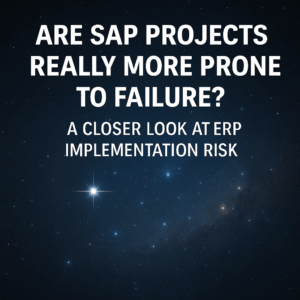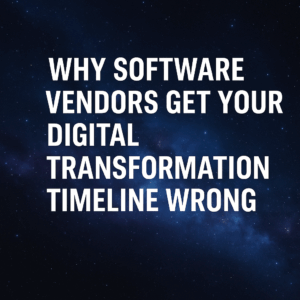Digital transformations are challenging endeavors but do you know what the number one cause of a failure is and what that number one step is that you should take to make sure your project does not fail?

When people think about digital transformation success versus failure, they often think about things like project management and governance and making sure we address change management, make sure we get our processes right, make sure we have our requirements well defined, a lot of things like that that are very important to digital transformation success.
The problem is, there’s an underlying reason why so many projects fail and most projects fail in the very early weeks and months of a transformation. It’s the very first step that you should be taking in a digital transformation initiative but most project teams overlook this first step.
Table of Contents
ToggleAlign Your Digital Strategy
When we’re looking at this phase zero, the implementation readiness, the digital strategy, the roadmap to planning that entire upfront phase of a project, one of the first components and one of the most important components is making sure that you’ve defined the parameters for your digital strategy in a way that’s aligned with your organizational strategy and objectives.
For example, if you’re an organization that’s going through mergers and acquisitions and you’re trying to integrate operations and create a common operating model, then one of your parameters, one of your decision points might be which areas of our business are we going to create a common operating model and sort of force the organization onto a common set of business processes. Additionally, which part of the business might we say we’re going to set aside and let those remain independent or decentralized.
Without that clarity and vision and that alignment between your digital strategy and your overall corporate strategy, you’re going to get misaligned pretty early on and if you’re misaligned early on, it doesn’t matter how well you manage the project, it doesn’t matter how well you handle organizational change management or define your business requirements, you’re not aligned as an organization and that’s going to lead to failure.
That’s a big part of why making sure that your digital strategy is aligned with your organizational strategy is so critical but yet it oftentimes is overlooked by organizations and their transformation teams.
Within this whole phase zero of your digital strategy you also need to be looking at your future state business processes. Most organizations have a tendency to think that we’ll just wait and see who our software vendor is and can do before we define our future state processes.
Now, there is some truth to that and some merit to that way of thinking because there’s certain capabilities that technology brings to the table that you may not even know about, you may not even be thinking about or envisioning for your organization. There are some inputs that technical capabilities should provide but if we go too far down that direction, what ends up happening is we defer so much to the technology that we don’t have a clear vision of what it is we want to be when we grew up operationally, we don’t know what sorts of business processes we want, we don’t know what we want the workflows to look like and the roles and responsibilities of people within the organization.
We’ve got to define that stuff early on because even though it’s going to take us more time and it might seem as though we’re slowing down the start of the project, it’s actually going to speed things up a lot more later on. If you just take your time to figure out what your future state business processes are independent of technology and certainly use technology where appropriate to augment and iterate what that feature state should be, that future state should really drive and serve as a blueprint for your overall digital transformation.
Assess Digital Maturity
The next step in this phase zero of digital strategy planning is to assess the maturity of your digital capabilities, in other words, what are your digital capabilities now versus what it is you might be looking to enable in the future.
For example, if you are using an old AS400 or i-series green screen based system from the 1980s, that’s okay, that’s who you are as an organization but it’s important to recognize the digital maturity or lack thereof that comes along with that. So in other words, if we’re going to take a jump from green screens or mainframe systems and now we’re going to go to a cloud-enabled artificial intelligence fueled type of digital transformation, that’s a huge leap.
Not to say you shouldn’t do it but you just need to understand where you’re starting from and what that maturity level is versus what the maturity level is going to be or need to be for your future state. The most difficult part of this phenomena is the fact that the bigger that chasm is between your digital maturity today and the digital maturity you’re trying to get to tomorrow, the bigger that chasm is, the longer it’s going to take to do your project, the more it’s going to cost and the more risk that’s entailed.
That’s not good or bad but too often organizations underestimate that divide or that jump from where they are today, to where they’re going or yet they don’t fully understand where they are today and what their real digital maturity capabilities are. Additionally, they don’t have a good estimate of what it’s going to take in terms of time cost and resources, so ensuring you’ve got a good handle on what your digital maturity is today and where you’re headed in the future is critical to making sure that your transformation is successful.
Assess The Organization
Once we have alignment on our digital strategy, we’ve defined our future state business processes, we understand our digital maturity or lack thereof, now we look at the organization itself. How are we organized, how are people doing their jobs, what are the roles and responsibilities and more importantly how are those roles and responsibilities going to change potentially in the future as part of our transformation.
The bigger the change in your organization the longer it’s going to take, the more it’s going to cost and the more risk you’re going to incur, so you really want to have a good, solid understanding of where you are today and what that future state organization is going to look like. This is especially true if you’re trying to move to a shared services model where you’re trying to consolidate HR, IT, finance or accounting or in cases where you are trying to create a common operating model throughout the organization and you’re trying to roll out common sales processes or common accounting and business intelligence processes.
The bigger those gaps and the bigger change, the more risky and the more important organizational change management will be to your project.
You don’t want to just assess your organization for assessment sake, you can create a change strategy and a change management plan that’s unique to you, that fits who you are today and where you’re headed as an organization and that is a really important input into your overall transformation plan and strategy.
If you don’t do this organizational assessment, you’re not going to have the right inputs into what it’s going to take from a change management perspective and you’re largely flying blind and you’re exposing yourself to too much risk. So that’s why this organizational piece of it is so important as part of the whole digital strategy implementation planning phase of a transformation.
Define A Transformation Plan
Once you’ve done all these things and you’ve assessed who you are and where you’re headed and all these different dimensions, then and only then can you realistically define a transformation plan, budget risk plan that are going to ensure that you’re successful. So, you want to take these inputs and make sure that you’re dialing in what your transformation strategy and plan needs to look like to make you successful.
This is also a good exercise to ensure that you’re all on the same page before you get started on the project. Organizations too often want to gloss over and skip over and just get straight to the technology and start building apps and modules and by doing these things that we talked about in this article, you’re just setting yourself up for more success and a likelihood that you’re going to take more ownership and have more accountability for the implementation and you’re going to be giving your software vendor your consultants your technology implementers a lot more direction and clarity on how they need to be deploying technology throughout your organization.

If you are looking to strategize an upcoming transformation or are looking at selecting an ERP system, we would love to give you some insights. Please contact me for more information eric.kimberling@thirdstage-consulting.com





